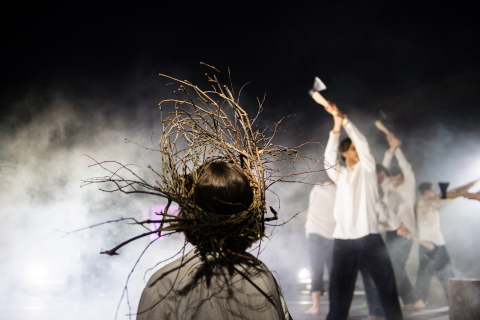Visiting Assembly’s Checkpoint venue always brings back fond memories and summons ghosts, as it was in this space that the legendary Forest Fringe was based for very many years. It is therefore always a delight to see the space used imaginatively, as it is here for this highly physical and visual Russian ensemble production, featuring recent graduates of the renowned Moscow Theatre Arts School. And it feels special and an interesting resonance that the piece I’m seeing here is called Forest!
I take my seat in the front row (there are two front rows, forming a kind of L-shape around the performance space, with both the stage and the floor in between used). In front of me is a mound of earth and some sort of large vessel, covered. To my left, a young man in a white robe is standing, holding a tall stave. A young woman is crouched down, by a sawn log that is standing up vertically in the space. In fact, there are very many young people dotted around the space, on the stage and in the auditorium, all clad in white robes. Lots of the logs too! At the back of the stage is a circular screen, a kind of glowing disc on which monochrome images of rippling water are projected.
The following 55 minutes bring us a beautifully enacted, ritualistic performance piece that is word-free, other than for the lyrics of the haunting songs (sung live, by the ensemble of fourteen, seven men and seven women) that accompany the physical action. And what a pleasure it is to see such a large ensemble at the Fringe! I have virtually no Russian, but I pick out one word that I understand – Nec. Forest.
Forest, inspired by the ‘New Russia’ philosophy of writer Vladimir Bibikhin, takes us on an elemental journey, honouring the five elements of the ancient world – earth, fire, wood, metal and water. We encounter these elements both literally and metaphorically: the smell of the earth and the stripped wood is tangible, the water splashed on faces real. Meanwhile, on screen, we take a bird’s eye view, then an earthworm’s view, of the primeval forest.
The show, devoid of any polemic, honours the natural world, and reflects on humankind’s relationship to it. Forest, unlike some other work at this year’s Fringe, is not here to preach about environmental concerns. It instead honours and praises the power of Mother Nature, and lets us form our own views on how we should relate to the earth.
One particularly strong scene sees timbers falling on screen, as one ensemble member after another climbs onto one of the tall, stripped logs and falls, straight-backed, into the arms of their companions – forward for the men, backward for the women (the ensemble is often divided in its actions by gender, which is a comment not a criticism). The message is clear, and doesn’t need to be spelled out: There are no divisions – we are the trees, and the trees are us.
The interaction between live and onscreen image is excellent, here and in other scenes. The ensemble are a skilled bunch, who work in male-female pairs, in gender-divided groups, or as a whole ensemble taking on archetypal ideas, exploring balance, conflict, birth and death. Scenes have names such as ‘Play – Intimacy’ and ‘Magic – Incantation’. We most definitely feel that we have been taken back to the very beginnings of theatre – we are witnessing (or taking part in) in an animistic ritual, honouring the earth and the spirits that inhabit and draw everything together.
The video work (by Kirill Pleshkevich) is excellent, mostly dreamily realistic with a touch of the surreal, reminding me sometimes of scenes of the natural world in Tarkovsky’s films; and the sound design (by Niyaz Karim) is of the highest quality. From my position in the auditorium, I can’t tell if the soundscape (beyond the live vocal and percussive work of the ensemble) is being created and mixed live or is pre-recorded – but either way, it is an exciting combination of Foley sound, pre-found sounds, and composition which uses guitar alongside less familiar instruments such as the kalimba. Direction and stage design is by Dmitry Melkin, who comes with a reputation for creating site-responsive devised work across Europe, and here has led his young ensemble into creating a series of strong, sculptural visual images, making enchanting sounds, and enacting physical movement motifs that explore archetypal human experience.
If you want a point of reference, Forest – in its blend of beautiful polyphonic singing and strong physical ensemble work – reminds me a little of Polish company Song of the Goat. The director, in his notes, talks of moving back to a fundamental theatre, and this is indeed what we have here – a theatre that is truly embodied, miles away from the intellectual, conceptual and abstraction of much contemporary theatre.

